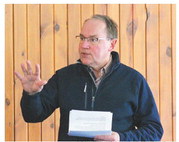Watershed grants increase farm conservation practice
The Wisconsin Department of Agriculture, Trade and Consumer Protection (DATCP), has released the 2022-23 impact report, for the Producer-Led Watershed Protection Grant Program (PLWPG), which shows that conservation practices among producer-led groups in the program rose by 43 percent, from 2022 to 2023.
These practices help reduce soil erosion and phosphorus loss from farm fields, ensuring that nutrients go into farmers’ crops, instead of local water sources.
“Wisconsin’s abundant soil and water resources are important to the success of our state’s $116.3 billion agriculture industry,” said DATCP secretary Randy Romanski. “The producer-led program and the conservation initiatives implemented by farmers in the program, continue to have a measurable impact. This helps preserve and protect soil health and water quality, throughout the state.”
Report data highlights the many ways the PLWPG helps increase the use of conservation practices across farmland in the state. According to the DATCP’s analysis, in 2023, there were 2,016 farmer members participating in producer-led groups, that operate 782,674 acres of Wisconsin cropland.
These groups conducted 182 outreach events to fellow farmers and community members, reaching 11,962 attendees, regarding numerous conservation and water quality topics in agriculture. The groups started and maintained, 93 on-farm demonstration and research projects, which help farmers, landowners and agricultural professionals, learn and implement new soil health strategies, and conservation systems.
Reported conservation practice acreage rose to 1.5 million acres in 2023, up from 1.1 million acres in 2022. More specifically, the program saw a 29 percent increase in acres covered by a nutrient management plan, a 15 percent increase in acres managed using no-till practices and a 2 percent increase in cropland receiving cover crops.
Since its inception in 2015, the DATCP has awarded more than $7.2 million to 52 groups, in watersheds across the state. Grant projects have focused on providing conservation education to farmers, conducting on-farm demonstrations and research, issuing incentive payments for implementing conservation practices, organizing field days, and gathering data on soil health and water quality.
The full report can be accessed at datcp.wi.gov.

